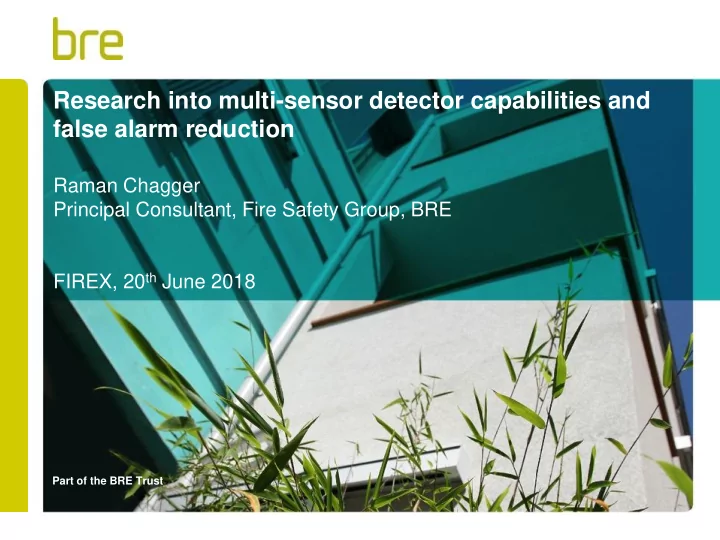

Research into multi-sensor detector capabilities and false alarm reduction Raman Chagger Principal Consultant, Fire Safety Group, BRE FIREX, 20 th June 2018 Part of the BRE Trust
Introduction – Losses from false fire alarms ~£1 billion/year in the UK – False alarms have consequences: • FRS – drain on/diverted resources • Businesses – disruptions/loss of productivity • Public - reduced confidence/frustration • Road traffic accidents
False alarm studies Study 1: The causes of false fire alarms in buildings Study 2: Live investigations of false fire alarms
False alarm studies Study 1: KCL 6 recommendations Potentially 49.5% reduction through the greater use of multi-sensors. Study 1: BMKFA Potentially 27.0% reduction through the greater use of multi-sensors. Study 2: SFRS 35 recommendations Potentially 35.1% reduction through the greater use of multi-sensors.
Multi-sensor detectors Heat – Multi-sensors utilise a number of Optical smoke sensors to provide more reliable Carbon Monoxide detection – Research with SFRS identified that no false alarms were caused from multi-sensor detectors – One of the recommendations “Further research is required to identify multi- sensors performance variabilities and capabilities ”. – As well as greater reliability fire sensitivity levels can be increased reducing detection times . Photo courtesy of Tyco Fire Protection Products
Optical/heat multi-sensor detector research – The BRE Trust, 12 manufacturers and the Fire Industry Association started a 3 phase research project – Phase 1: Review of multi-sensor capabilities and variabilities. Identify tests – Phase 2: Performing a broad range of test fires (compare with optical) – Phase 3: Performing a broad range of common false alarm tests to identify multi-sensor immunity. – Aim of identifying relative benefits of multi-sensors over optical detectors
Video
Phase 1: Identification of false alarm tests Dust (long term) Dust (short term) Smoke from cooking Steam Condensation Aerosols (hairspray/deodorant) Smoke from toaster Cigarette smoke Synthetic (smoke machines) Insects Thermal shock Apparatus for the Test of Fire Detectors in Dusty Environments (AUBE14_S09P02)
Phase 1: Identification of false alarm tests Dust (long term) Dust (short term) Smoke from cooking Steam Condensation Aerosols (hairspray/deodorant) Smoke from toaster Smoke from cooking Cigarette smoke 2.0 1.8 Synthetic (smoke machines) 1.6 1.4 Insects m (dB/m) Test 1 1.2 1.0 Test 2 Thermal shock 0.8 Test 3 0.6 Test 4 0.4 0.2 Test 5 0.0 600 800 1000 1200 Time (sec)
Phase 1: Identification of false alarm tests Dust (long term) Dust (short term) Smoke from cooking Steam Condensation Aerosols (hairspray/deodorant) Smoke from toaster Cigarette smoke Synthetic (smoke machines) Insects Thermal shock Apparatus for the Test of Fire Detectors in High Foggy Environments (AUBE14_S09P02)
Phase 1: Identification of false alarm tests Dust (long term) Dust (short term) Smoke from cooking Steam Condensation Aerosols (hairspray/deodorant) Smoke from toaster • Aerospace standard AS8036 Cigarette smoke (2013-12) Synthetic (smoke machines) • Cargo Compartment Fire Insects Detection Instruments Thermal shock
Phase 1: Identification of false alarm tests Dust (long term) Dust (short term) Smoke from cooking Steam Condensation Aerosols (hairspray/deodorant) Smoke from toaster Cigarette smoke Smoke from toast 3.0 Synthetic (smoke machines) 2.5 Insects 2.0 m (dB/m) Test 1 Thermal shock Test 2 1.5 Test 3 1.0 Test 4 0.5 Test 5 0.0 300 350 400 450 500 550 600 Time (sec)
Phase 1: Identification of fire tests Utilised the methodology from previous work into test fires Test fire m:y Δ t (dB/m) (°C) ABS (S) 3.04 2.9 Flame retardant PU foam (S) 1.88 2.5 TF2 Wood (S) 1.08 1.8 TF3 Cotton (S) 0.528 2.0 TF4 PU foam (F) 0.235 21 TF5 N-heptane (F) 0.168 35 TF8 Decalin (F) 0.25 6 Nylon (F) 0.168 5 Flame retardant PU foam (F) 0.094 5 TF1 wooden crib (F) 0.079 24 (F) = Flaming; (S) = Smouldering
Phase 2: Fire tests – 36 types of different optical heat multi-sensor detectors tested alongside 2 reference optical smoke detectors – Multi-sensors categorised in terms of their false alarm immunity
Phase 2: Fire tests (PU Foam example)
Phase 2: False alarm tests (Toast example)
Phase 2: False alarm tests (overview) 248% 250% Multi-sensor response normalised to optical (%) Multi-sensor detector average 216% 207% Optical smoke devices average 191% 200% 182% 150% 100% 50% 0% Toast (dB/m) Cooking (dB/m) Water mist Dust (dB/m) Aerosol (sec. (dB/m) dB/m) False alarm test
Phase 2: False alarm tests (overview)
Conclusion - Research has demonstrated that multi- sensor detectors can have the same response to fire but delayed response to false alarms - The performance is dependent on the sensitivity levels - FIA and BRE are working to intending to develop a Loss Prevention Standard for False Alarm Resistance - FIA guidance on false alarm reduction available from: http://www.fia.uk.com/cut- false-alarm-costs.html - BRE briefing papers (+ videos) are available free of charge from: http://www.bre.co.uk/firedetectionresearch
Thanks S. Brown Consulting Services Ltd Thanks to UBM for use of images in this presentation
Recommend
More recommend